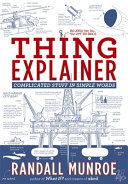Part 3
The Thing Explainer: Understanding How Stuff Works, Simply!
Imagine a book that explains how a spaceship works using only words a toddler might know – words like "box," "stick," "push," and "big." That's exactly what Randall Munroe did in his super-cool book, "The Thing Explainer"! He takes complicated things – like the human body, spaceships, the internet, and even zippers – and explains them using only the 1,000 most common words in English. It's like having a secret code to understand the universe!
Let's start with something familiar: a bicycle. You know it has wheels, pedals, and handlebars, right? But how does it *really* work? Munroe would say it's a big metal box (the frame) with two round things (wheels) that spin. When you push on the sticks (pedals), they make a stick (the chain) turn a bigger stick (the gears). This makes the wheels spin, and the whole box moves! See? No confusing words like "torque" or "sprockets." Just simple actions – pushing, turning, and spinning – that explain the whole thing.
Now, let's zoom out to something HUGE: the International Space Station (ISS)! It's like a giant house floating in space, made of lots of big metal boxes (modules) stuck together. Inside these boxes are smaller boxes (equipment) that keep the astronauts alive, like special boxes for air and water. The ISS has giant sticks (solar panels) that catch the sun's light and turn it into power – like having tiny suns powering the whole station! To move around, the ISS uses big push things (rocket engines) that shoot out gas, pushing it in the opposite direction. It's like a super-powered, super-complicated toy, but all the parts are doing simple things to make it work.
Let's get even smaller – down to you! Your body is like an amazing, complicated machine, even more incredible than a spaceship! Your heart is a pump, a powerful muscle that pushes red liquid (blood) around your body through tiny tubes (blood vessels). Think of it like a super-efficient delivery service, carrying oxygen and nutrients to every part of your body. Your lungs are big bags that take in air (to get oxygen) and let out air (to get rid of carbon dioxide). They're like air filters for your body. Your brain is a big, squishy thing that controls everything – like a supercomputer made of jelly! It sends messages to all parts of your body through tiny wires (nerves), telling your muscles what to do, whether you're running, jumping, or even thinking about your next snack.
What about the internet? Munroe explains it as a giant network of connected boxes (computers) that talk to each other. These boxes share information using light pulses sent through thin glass tubes (fiber optic cables) all around the world. It's like a massive, global telephone system, but instead of voices, it carries pictures, videos, and all sorts of information. Think of it as a giant web connecting everyone's computers, letting them share information instantly.
Munroe even explains seemingly simple things in a surprising way. A zipper, for example, isn't just a pull-tab; it's a bunch of tiny interlocking teeth that slide past each other. The simple act of zipping up a jacket is actually a marvel of engineering! Even a pencil – a long stick (graphite) inside a wooden box (the casing) – is cleverly designed to let you leave marks on paper.
The amazing thing about "The Thing Explainer" is that by using only simple words, Munroe makes us focus on how things *really* work. He strips away all the fancy scientific jargon and gets to the heart of the matter. It's like peeling back the layers of an onion to find the core – the basic principles that make everything work. He shows us that even the most complex machines and systems are built from simple parts working together in clever ways. It's a reminder that even the most advanced technology is based on simple ideas.
For example, imagine explaining a car. Instead of using words like "engine," "transmission," and "differential," we could say it's a big metal box with spinning round things (wheels). You push on a stick (the gas pedal), and the box moves. This simplified explanation doesn't cover everything, but it gets across the basic idea: pushing something makes it move. That's the beauty of Munroe's approach – to simplify the complex and reveal the underlying principles.
Lesson
The most complicated things in the world are built from simple parts working together. By understanding the basic actions – like pushing, pulling, spinning, and connecting – we can understand how almost anything works!
